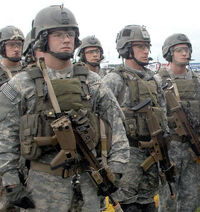| US Army Rangers | |
|---|---|

| |
| Weapons | M4 Assault Rifle, SR-25 Sniper Rifle, Claymore Mine, SOCP |
| Origin | United States |
| Activities | US Military Service
Special Operations |
| Service | Pre-colonial to present World War II-present (officially) |
| Battle Status | Won vs. NKSOF |
| Experts | SSGT Daniel K. Jones (Army Ranger) Lt. Col. John Lock (Fmr Army Ranger/Historian) |
"Rangers lead the way!"
- Motto of the US Army Rangers
"We don't fight fair. We have a ferociousness, a tenacity, and this violent approach to battle. Killing is what Rangers do best!"
- Sgt. Daniel K. Jones, U.S. Army Ranger.
The US Army Rangers, America's premier light infantry division, who would lead America's massive counter-attack.
vs the North Korean Special Operations Force, extremist super-commandos poised to launch a communist invasion of South Korea.
Stats
- Height - 5'9
- Weight -175
- Age - 24
- Symbol- A grinning skull with a faint outline and filled in eye and nose hole wearing a beret with patch.
History
The Rangers can trace their lineage back to the Mid 1700's when regular military personnel were bewildered by the unique fighting techniques of the local Native Americans.

In 1676, Colonel Benjamin Church mixed Indian and European warfare and the American Ranger was born. The Rangers served in the French and Indian Wars, the American Revolution, and the American Civil War on both sides.
The modern Rangers were officially born in World War II, when Major General Lucian K. Truscott, the US Army Liaison, saw the capabilities of Britain's SAS Commandos and proposed that America form a similar unit. After weeks of weeding out the thousands of applicants, the 1st Ranger Battalion was activated on June 19, 1942. The Rangers have served in every American conflict since.
Weapons
| Medium Range | M4 Assault Rifle |
| Long Range | SR-25 Sniper Rifle |
| Special Weapons | M18A1 Claymore |
| Hand-to-Hand Combat | SOCP |
In addition to the weapons and tactics discussed on the show, the tactics the US Army Rangers would use in a theoretical counter-attack on North Korean forces if they invaded South Korea was discussed in a video clip released on Spike.com. The tactics were declared even when compared to the SOF's tactics, and thus was not featured in the episode.
X-Factors
Discipline: 83
Terrain Familiarity: 78 (they train to be effective anywhere, especially the Korean Peninsula, where their enemy has the advantage)
Extremism: 83 (while they create havoc among their enemy, they try not to panic the civilians and have to be careful about whom they are trying to kill with their weapons)
Psych Warfare: 74 (although they do want to appear threatening, they want to avoid killing civilians)
Operational Experience: 85 (operating worldwide during their missions, just like the Navy SEALs)
Hand-to-Hand Combat: 89 (SOCP)
Simulated Battle
North Korea has invaded the South again after 50 years, and the US has launched a counter attack. Somewhere along the Korean Peninsula, a group of 5 U.S. Army Rangers are getting set to raid a Korean occupied facility. The lead Ranger gestures with his arm, and the other Rangers copy as they march up to the facility. The Ranger sniper separates himself from the group and sets up his SR-25 rifle, surveying the area. He soon finds the enemy sniper and his spotter on a ledge, and a patrolling soldier further down. The Ranger takes aim and takes out the sniper. ![]() He quickly changes targets to the half-aware patrolling soldier and quickly downs him.
He quickly changes targets to the half-aware patrolling soldier and quickly downs him.![]() The sniper quickly vacates the area, hauling away the sniper rifle while the spotter crawls to avoid any further engagement and takes his AKM assault rifle.
The sniper quickly vacates the area, hauling away the sniper rifle while the spotter crawls to avoid any further engagement and takes his AKM assault rifle.
Meanwhile, the Ranger group marches slowly up a drainage ditch when one ranger trips a box landmine, sending him flying. Hearing the commotion, two Korean Special Ops emerge from a doorway and begin exchanging full-auto volleys with the Rangers. The injured Ranger calls for help while another Ranger braves the shots and attempts to pull the downed man to safety. The Korean from the roof fires his PSL in rapid fire, cutting down the brave soldier. ![]() The downed Ranger soon succumbs to the blood loss from his injured leg.
The downed Ranger soon succumbs to the blood loss from his injured leg. ![]() Both sides continue to fire on each other until all three Koreans fall back into the facility. Seeing their chance, the Rangers begin their advance after the Koreans.
Both sides continue to fire on each other until all three Koreans fall back into the facility. Seeing their chance, the Rangers begin their advance after the Koreans.
Back inside, the Korean leader gestures to his friend to ambush them from the stairs while he goes on ahead. Two Rangers follow them into the building and are met with assault rifle fire. The Rangers waste no time and quickly kill the attacker, sending him over the railing.![]()
Meanwhile, the Ranger sniper comes to another part of the facility and whips off his backpack. A nearby NKSOF hears the commotion and goes to investigate. The sniper finishes rigging up a Claymore landmine, but is stopped dead in his tracks by the SOF's rifle fire. The intruding soldier walks up to confirm his kill, but the sniper, barely showing signs of life, presses the detonator. He is killed by the mine's explosion while the Korean is flung into the air and killed by the deadly shrapnel. ![]()
![]()
Back inside the facility, both of the remaining Rangers are searching for the Korean leader. While cleverly hidden the shadows, the Korean kills one of the Rangers when he comes too close.![]() The Korean fires off his last round at the Ranger leader before hearing the clicking of an empty magazine. The Korean runs for the stairs as the Army leader spots him and takes a shot at him. The Korean commander sets his rifle down under cover from the stairs and continues his escape, while the cautious Ranger leader makes his way after him.
The Korean fires off his last round at the Ranger leader before hearing the clicking of an empty magazine. The Korean runs for the stairs as the Army leader spots him and takes a shot at him. The Korean commander sets his rifle down under cover from the stairs and continues his escape, while the cautious Ranger leader makes his way after him.
The Korean sets himself hidden behind a wall and waits for the Ranger. The Ranger soon gets within range of the Korean as he tries to wrest his M4 away from him. The Ranger fights back and hits him across the face with the rifle. The Korean attacks with a spinning hook kick which spins the Ranger around and to his knees. The Korean tries to choke him from behind, but the Ranger flips him over his shoulder. Before he can do anything, the Korean kicks him in the head, knocking him down. The Korean gets to his feet as the Ranger does the same and tries to kick the M4 away from his hands. The Ranger stands his ground as the Korean then manages to hold down the rifle with his hands, but the Ranger counters with a head butt. The Ranger stomps at the Korean to keep his distance and shoots him, dropping the Korean dead. ![]() The Ranger leader turns to the camera, raising his fist and shouts "Rangers lead the way!" in victory.
The Ranger leader turns to the camera, raising his fist and shouts "Rangers lead the way!" in victory.
Expert's Opinion
Even though the NKSOFs had the home field advantage on the Korean Peninsula, what allowed the Rangers to win was their operational experience worldwide, the effective nature of SOCP, and the devastating power of the Claymore mine.
Trivia
- This battle is the first to be set up in a specific geographic location, the Korean Peninsula along the coast of North Korea. The battle is set in a location that gives one of the warriors an advantage over the other, since the NKSOF are fighting on their own turf. (Others include Viet Cong and Medellin Cartel.)
- This is considerably a very close match-up with a difference of 8 battles between the two armies. It is the closest match up in the history of Deadliest Warrior.
- The motto "Rangers lead the way" became the Rangers' motto during World War II when in a meeting with the 5th Ranger Battalion, General Norman Cota asked, "What outfit is this?" Someone yelled, "5th Rangers!" In an effort to inspire the men to leave the cover of the seawall and advance through a breach, Cota replied, "Well, God---- it then, Rangers, lead the way!"
- The US Army Rangers was voted the most popular warrior of season 3. Despite this, the Rangers vs NKSOF episode is considered to be one of the most controversial episodes due to how close the final score was and the fact that their battle could happen in real life since they are still big enemies to each other.
- A video that wasn't shown in the episode shows Machowicz discussing with the Ranger/NKSOF specialists about the results of North Korea invading and the US/South Korean response. Video source
- Invasion: Thomas Rix details that the North Korean military would use a surprise attack, including amphibious landings along the South Korean coastline using high-speed boats to land troops. These boats would insert troops undetected along the coastal inlands, conquering Kwangju, Pusan and Taejun before the South Korean Army could respond. H-Hour would begin with a massive artillery barrage on US/SK forces on the DMZ and Seoul, the SK capital, and surrounding military bases. The NKPA would then send their men and equipment through tunnels into the South, hitting airbases, securing the railroads and conquer Seoul, the political and military center of South Korea. The North Korean "People's" Army would then attack and conquer all over the South, followed by airborne troops, which the NKSOF does have a division for.
- American Counter-Attack (John Lock gives 3 scenarios)
- Scenario 1: This would involve combat parachute assault, mostly starting in Pusan. The Army Rangers would need to secure key terrain such as mountain passes, for the heavy armor to make it's way up, tunnels and bridges over main rivers. More airborne Ranger divisions would fly in over Taejun and Seoul to hold chokepoints. The Rangers would bring in their sniper teams, taking out NK commanders and taking out weapons systems. The armored divisions would then land on Pusan beaches and engage the enemy.
- Scenario 2: The Army Rangers' task in this scenario would be to secure a port of entry, similar to D-Day of 1944. The Rangers would either secure Yangyang as a port of entry, pouring troops inland en masse. The troops would then spread out and move further inland, cutting off the North Korean troops.
- Scenario 3: Finish off North Korea. The North Korean Army has been crushed and forced out of the South but still holds their pre-war borders. North Korea will then most likely start to use the nuclear weapons they claim to possess, for their is nothing for them to lose (and the North Korean government possibly has a Hitler personality in a "take them with us" as they are defeated). The US would need to secure the WMD sites. The US Army Rangers would be flown in, parachuting over these sites to secure them. Then the US military would then move on Pyongyang, the NK capital, conquer it and kill Kim Jung-un and his cabinet.